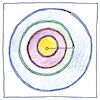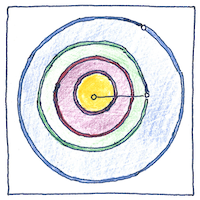Giovanni Domenico Cassini
astronomy

|
Planetary distances
Cassini stayed in Paris, and sent his assistant, Jean Richer, to Cayenne, ten thousand kilometers away, so they could simultaneously measure the distances between Mars and certain distant planets. Based on the parallax, Cassini calculated the distance between Earth and Mars. Given that distance and known ratios between the planets, Cassini calculated the distances of all the planets to the sun.
The astronomical unit
Archimedes, Aristarchus, Eratosthenes, Hipparchus, Ptolemy, al-Battānī, Copernicus, Tycho Brahe, Kepler, Godefroy Wendelin, Jeremiah Horrocks, and Huygens all gave distances between the earth and the sun, and they were all wrong. Even Cassini was short by seven percent. Huygens’ number was closer but that was only due to luck.
Astrology
Giovanni Cassini’s first interest was in astrology. He worked for Louis the Fourteenth as both an astronomer and astrologer. Even astrologers need to know where in the sky the planets are. Thus common knowledge redeems the quirky stuff. We might all like to feel connected to the universe; we might all need to believe. We might all excuse astrology as a harmless diversion. After all, there could be an observable order in the universe and surely careful study of people and events has shown everything or everyone is special although in different ways.



Because planetary orbits are elliptical, the planets’ distances from the sun depends on their places in their orbits. Kepler’s laws of planetary motion describe these elliptical orbits.
Cassini was not the only famous astronomer before the Enlightenment who cast horoscopes for kings or queens.
See also in The book of science:
Readings in wikipedia: